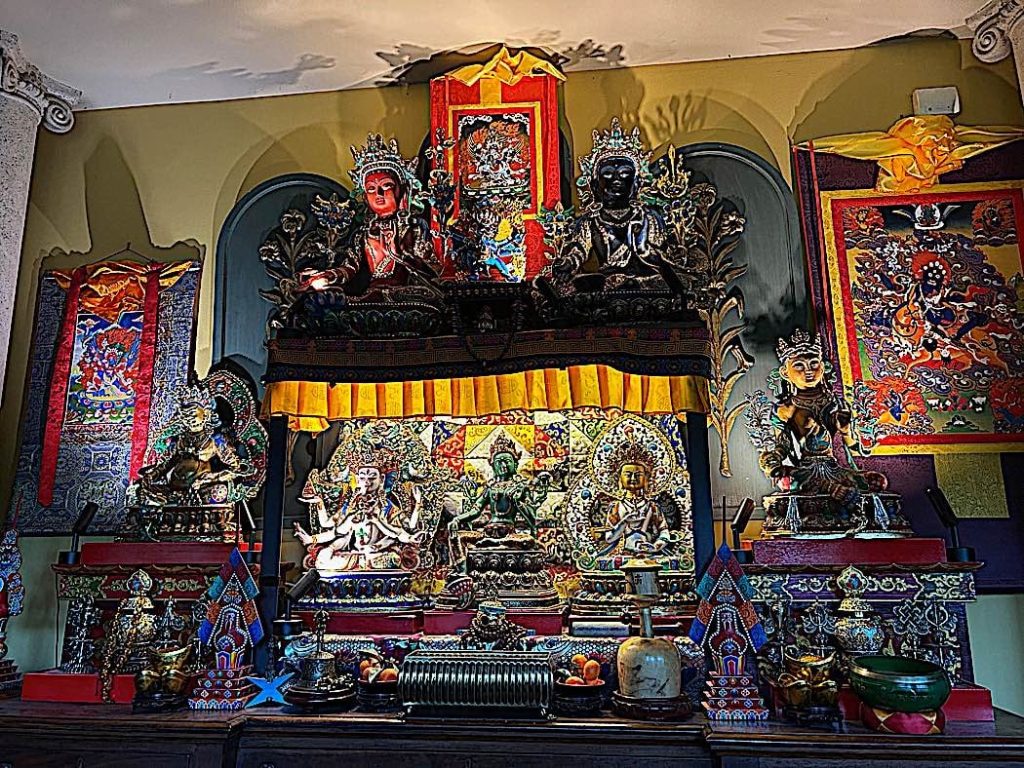
A home meditation altar provides a dedicated space for mindfulness, reflection and inner peace. If you are into Buddhist teachings or simply want a sacred place to cultivate stillness, creating an altar can improve your practice. A thoughtfully arranged space can serve as a visual and spiritual reminder to pause, breathe and reconnect with yourself daily. These are some tips on how to create an altar for meditation that meets your needs.
By Beth Rush
Biography below.
[Disclaimer: Always seek the advice of your health care practitioners when experiencing pain or other medical issues.]
1. Choosing the Right Location
Select a quiet area in your home where you can sit comfortably without distractions. This space doesn’t need to be huge, but it should feel peaceful and separate from busy areas. For example, some people prefer a corner of a bedroom or a designated meditation room, while others create a small nook on a shelf or table. Wherever you feel is a good place to connect with gratitude and present is ideal.
2. Gathering Essential Elements for Your Altar
A meditation altar can be as simple or elaborate as you like. Here are some meaningful items to consider incorporating:
- Statues or images: Many practitioners place a statue of the Buddha or an image of a revered teacher to inspire their practice.
- Candles or oil lamps: Lighting a candle symbolizes enlightenment and works as a focal point for meditation. In Buddhist traditions, candles represent the light of wisdom dispelling the darkness of ignorance.
- Incense or essential oils: These elements purify the mind and the environment [1] while creating a calm atmosphere. For example, sandalwood incense relates to mental clarity and concentration, while jasmine deals with relaxation.
- Crystals or stones: Some people use stones like amethyst or quartz to bring a sense of grounding and clarity. Each crystal carries unique properties that can improve your meditation. For example, amethyst is believed to promote spiritual awareness, while rose quartz fosters love and compassion.
- Sacred texts or scriptures: A book of Buddhist teachings [2] can deepen your understanding and provide guidance. You can also place handwritten sutras or prayer scrolls on your altar as a way to honor ancient wisdom and maintain a connection to your spiritual lineage.
- Personal items: Add elements that hold spiritual significance. A handwritten intention, a small bowl of water that symbolizes purity and renewal, or natural elements like flowers representing the importance and beauty of the present can personalize your altar.
3. Setting an Intention for Your Space
An altar should reflect your personal spiritual journey. Consider setting an intention for your meditation space. This can be cultivating compassion, finding clarity, practicing being thankful or just being present. Each time you sit before your altar, take a moment to reaffirm this intention. Some questions that serve as starting points are:
- What questions am I seeking answers to?
- What am I grateful for at this moment?
- In what ways can I practice self-comparison daily?
- What Buddhist teachings or practices help me deepen my compassion?
- How can I strengthen my mindfulness?
- What teaching of the Dharma am I most grateful for?
Your questions function as an inspiration for setting intentions on your altar. Take into account that mantras deepen your intention. They can be used for pacifying, [3] mindfulness, compassion and more.
4. Incorporating Your Altar Into Daily Practice
Once you know how to create an altar for meditation, it’s time to take the next step. Regularly spending time at your altar helps reinforce mindfulness and consistency in your practice. Even a few minutes each morning and evening can make a difference in your mental well-being and help you connect with your practice.
One of the most common practices of a self-care routine [4] is meditation, as it is proven to improve mental health [5] while reducing stress and promoting emotional balance. Other actions you can take to support your emotional wellness are short breathing exercises and checking in with yourself before starting.
5. Maintaining Your Sacred Space
Treat your altar with respect by keeping it clean and organized. Regularly dusting, replacing candles, and refreshing flowers or offerings can maintain its sacred energy. If your practice evolves, feel free to adjust your altar accordingly.
Quick Facts About Improving Your Meditation Altar
- How can I start my practice? An effective way of beginning to connect with your inner self is by simply following your breathing [6] through cycles and by paying special attention to the process. You can also include music and use guided meditation while entering your zone.
- How do different Buddhist traditions approach altars? While Tibetan, Zen and Theravada Buddhists may have different styles of altars, the common goal remains the same — creating a space for meditation and contemplation.
- What is the significance of incense in Buddhist practice? Incense is often used to purify the space and symbolize the impermanence of life.
- Can I create an altar if I am not Buddhist? Yes! Many people set up altars for personal reflection, mindfulness or spiritual connection.
Making Room for a Sacred Space
The answer to how to create an altar for meditation begins with identifying the purpose as spiritual growth, reflection and inner peace. Continue by personalizing your altar and integrating it into your daily routine. It is a tangible reminder of your commitment to a more centered and harmonious life. Whether you are deeply immersed in Buddhist teachings or are exploring meditation for the first time, having a dedicated space can deepen your connection to mindfulness.
Sources:
[1]https://www.elements-magazine.com/8-different-purposes-of-incense-in-buddhism/
[4]https://www.urac.org/wp-content/uploads/2023/05/do-something-for-yourself-today-MHAD.pdf

